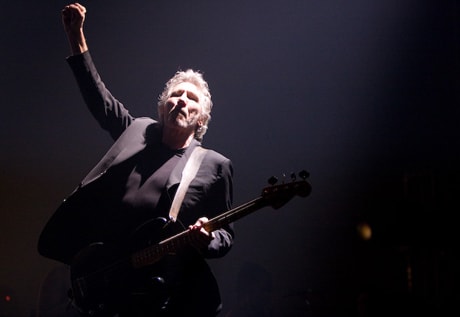Roger Waters steered clear of small talk when he played The Wall for the first time in 20 years to a sold-out crowd at the Air Canada Centre. He brought home the anti-war, anti-consumerist, anti-alienation messages of the classic Pink Floyd epic with imagery more real, recent and poignant than before. Aside from thanking the audience after the performance, Waters did exactly what he advertised: he played 1979's The Wall front to back. The epic wall built between the band and the audience during the original The Wall Tour in 1980 and 1981 - a stage spectacle that's influenced virtually every major touring band since - was recreated.
But beyond reproducing the album alone, Waters, backed with a 12-man band and 70-person crew, used the familiar album to bring new meaning to the messages he tried so hard to convey when he first wrote and performed The Wall. So to comment at length on the musical capabilities of the musicians (who were competent: Waters had some weak moments emulating some of former bandmate David Gilmour's vocals, as did session vocalist Robbie Wyckoff, but this was well-made up for, in the very least, by the face-melting guitar solo in "Comfortably Numb") would be pointless in comparison to commenting on the performance. As the 36-foot-high wall was built, huge, colourful, and harsh images were projected upon it - crosses and Stars of David falling from the sky until it turned red during "Goodbye Blue Sky"; photos and profiles of casualties of numerous wars for "The Thin Ice"; an eerie set of eyes during "Young Lust" and throughout the over-two-hour set. Familiar animation scenes from the film version of The Wall popped up during both "Empty Spaces" and "The Trial," as did inflatable versions of the films characters (Pink Floyd's infamous inflatable pig appeared as well, though this time it was black and covered with messages).
Perhaps the most poignant images the wall showcased was a red reproduction of Wikileaks-released video of U.S. troops killing three people in 2007, including Reuters journalists Saeed Chmagh and Namir Noor-Eldeen during "Run Like Hell." The audience were able to buy as many Roger Waters mugs and keychains as they wanted (double-bagged with Roger Waters bags), which diluted the anti-consumerist message the artist tried to put forward - but the performance itself showed that he's still got some major qualms with the system. Mother, does Roger Waters trust the government in 2010? No - even less than he did 30 years ago.
But beyond reproducing the album alone, Waters, backed with a 12-man band and 70-person crew, used the familiar album to bring new meaning to the messages he tried so hard to convey when he first wrote and performed The Wall. So to comment at length on the musical capabilities of the musicians (who were competent: Waters had some weak moments emulating some of former bandmate David Gilmour's vocals, as did session vocalist Robbie Wyckoff, but this was well-made up for, in the very least, by the face-melting guitar solo in "Comfortably Numb") would be pointless in comparison to commenting on the performance. As the 36-foot-high wall was built, huge, colourful, and harsh images were projected upon it - crosses and Stars of David falling from the sky until it turned red during "Goodbye Blue Sky"; photos and profiles of casualties of numerous wars for "The Thin Ice"; an eerie set of eyes during "Young Lust" and throughout the over-two-hour set. Familiar animation scenes from the film version of The Wall popped up during both "Empty Spaces" and "The Trial," as did inflatable versions of the films characters (Pink Floyd's infamous inflatable pig appeared as well, though this time it was black and covered with messages).
Perhaps the most poignant images the wall showcased was a red reproduction of Wikileaks-released video of U.S. troops killing three people in 2007, including Reuters journalists Saeed Chmagh and Namir Noor-Eldeen during "Run Like Hell." The audience were able to buy as many Roger Waters mugs and keychains as they wanted (double-bagged with Roger Waters bags), which diluted the anti-consumerist message the artist tried to put forward - but the performance itself showed that he's still got some major qualms with the system. Mother, does Roger Waters trust the government in 2010? No - even less than he did 30 years ago.
